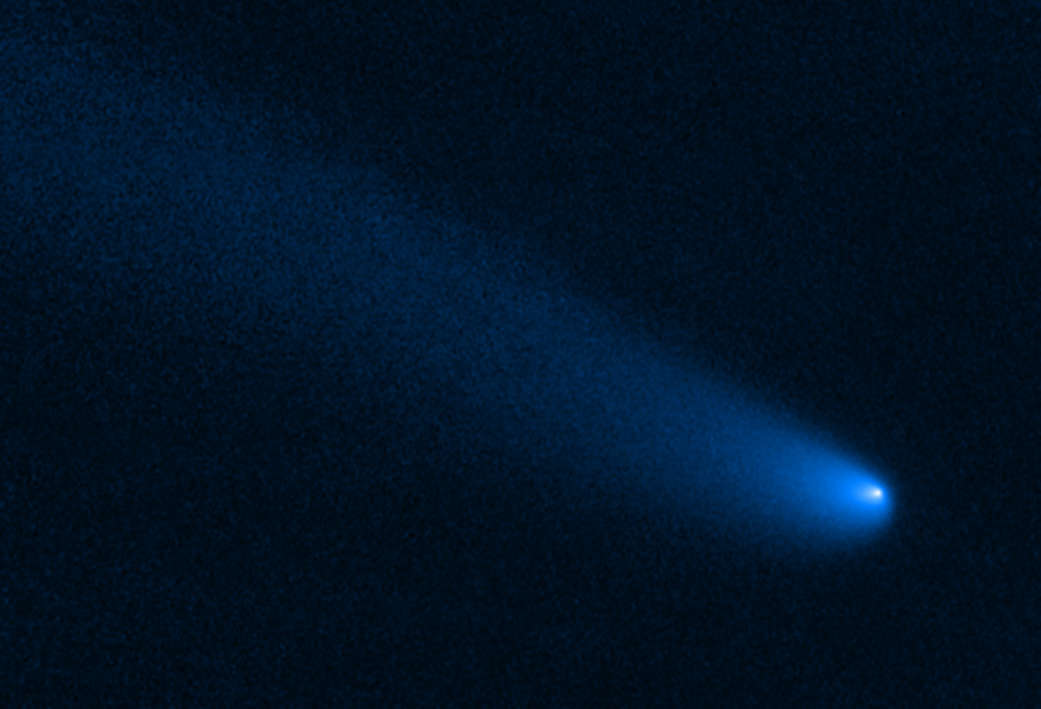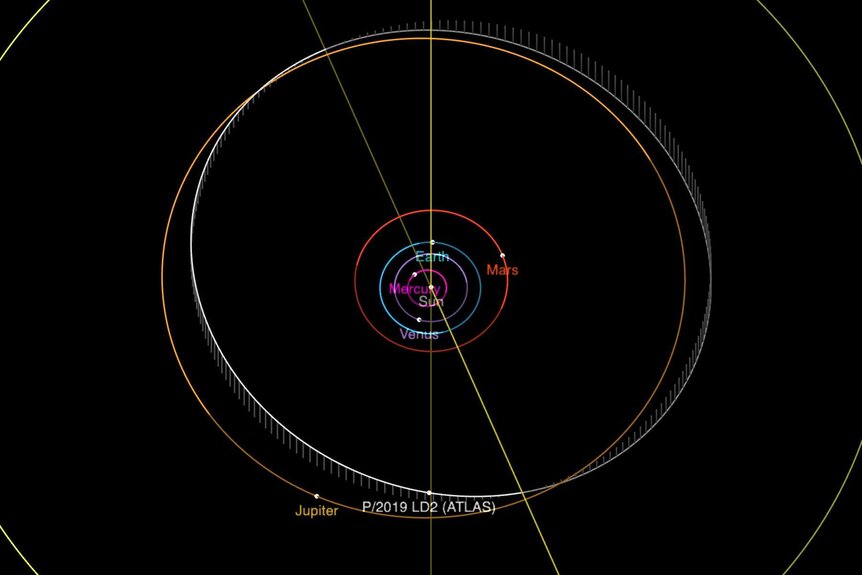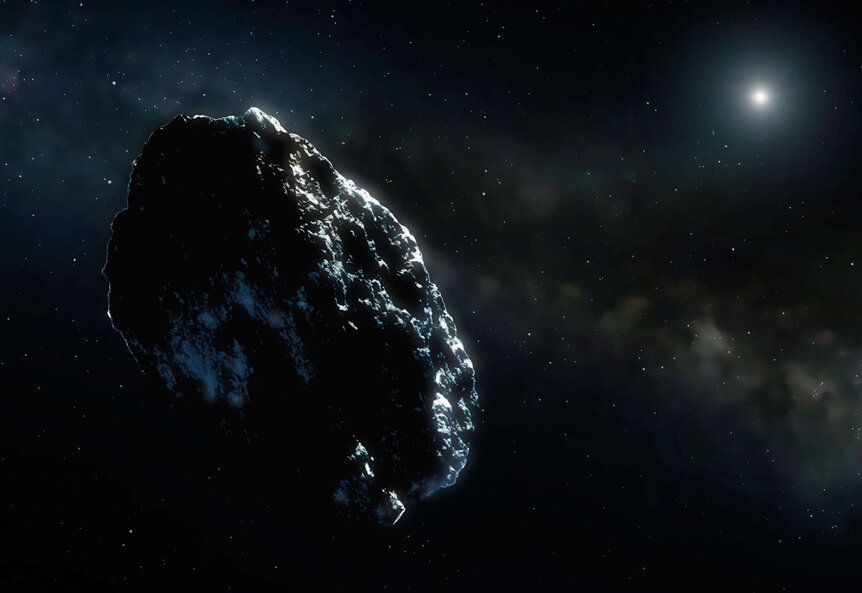Create a free profile to get unlimited access to exclusive videos, sweepstakes, and more!
A comet makes a pit stop near Jupiter but will eventually get flung into interstellar space

In June 2019, the automated survey ATLAS (Asteroid Terrestrial-impact Last Alert System) found a new object moving against the background stars. Initially called 2019 LD2, it was thought to be an asteroid orbiting the Sun out near Jupiter. However, an amateur astronomer noticed it appeared to be fuzzy, not point-like, which means it was more like a comet: Icy material on the surface turning into a gas as it's warmed by the Sun.
Checking archived images, astronomers determined it had been "active" for several months at least. The name of the object was then changed to P/2019 LD2, indicating its status as a periodic comet.
Images by other observatories confirmed this, including Hubble. When they looked at the comet in April 2020 they saw it sporting quite a grand tail, extending for about 600,000 kilometers, nearly twice the distance of the Moon from the Earth! Mind you, the nucleus — the solid part of the comet — is probably only about 4 kilometers across.
Calculations show that around that time it was losing about 80 kilograms of water ice per second. It was also shedding gases like carbon monoxide (about 50 kilos/second), carbon dioxide (7 kilos/second) and diatomic carbon (two carbon atoms bound together; at a rate of 40 grams per second).
That may sound like a lot, but it turns out it just started outgassing like this... and it won't for very long. It's status as a periodic comet is only temporary. Extremely temporary: Follow-up measurements to determine its orbit found it's actually in a similar orbit as Jupiter, and there's an excellent chance that, in the distant future, the mighty gravity of the giant planet will fling the comet out of the solar system entirely.
When that happens it will become an interstellar comet like 2I/Borisov or 'Oumuamua, interstellar objects that both recently passed through our solar system (and which, I'll note, are not alien spaceships).
That's fitting, since it probably began life in the outer reaches of the solar system, too.
It's likely that P/2019 LD2 started out as what's called a Trans-Neptunian Object, an icy body orbiting the Sun in the Kuiper Belt out past Neptune. Over time, very gentle nudges by Neptune's gravity urged it into a smaller orbit, closer to the Sun. Eventually it got close enough that Neptune could yank on it much harder, changing its orbit substantially, putting it in an orbit between that of Jupiter and Neptune (from about 800 million to 3 billion kilometers from the Sun). Objects on orbits like that are called Centaurs.
Centaurs are interesting. Over time, the gas giants tend to change their orbits still more. Generally, after a few million years in this part of the solar system, they get too close to one of the planets. Either they get dropped down into the inner solar system (and become what we call Jupiter Family Comets) or get thrown out of the solar system entirely. Because of that we call them transitional objects*.
What will be the fate of P/2019 LD2? And where did it originally come from?
Observations over time of an object can be used to determine its orbit, which can then be projected into the past and future. The problem is we can't measure the orbit exactly; there's always some uncertainty in it. The farther you try to predict its position in the future (or antedict its position in the past) the fuzzier it gets, the bigger the volume of space it might occupy. That makes this sort of prognostication dicey.
To get around this, astronomers did something clever: They simulated its orbit using what's called a Monte Carlo technique. They take the physical characteristics of the orbit (the shape, the distance from the Sun, the tilt, and so on) and then change each one very slightly, creating a slightly different orbit. They then run that into the past and future and see what it does. They do this again and again, creating a virtual cohort of objects each with marginally different paths. This way, you get a more statistical idea of what the history and future of the object was and will be.
What they found for P/2019 LD2 is that it probably only entered Jupiter's space about 2.5 years ago! Before that it was a standard-issue Centaur, but got nudged into its current orbit very recently.
And its future? They found it likely that it will only stay in its current orbit for 8 or 9 more years. After that it will likely drop down into the inner solar system, becoming a Jupiter Family Comet. This means is that it's only making a pit stop near Jupiter.
Even that's temporary. It has a 50% of being ejected from the solar system in 340,000 years, which rises to 95% in 4 million years.
It's likely that, over the age of the solar system, billions of objects like this have been ejected. And there are billions of stars like the Sun… which is why astronomers think the galaxy is loaded with rogue interstellar iceballs like P/2019 LD2, and why it's not so surprising that we see them passing through our solar system, too.
Will some alien scientists in the distant future see LD2 passing through their own system? What would they make of it? It's fun, and oddly reassuring, to know that pieces of our neighborhood will be scattered among the stars, going from citizens of our solar system to citizens of the galaxy.
*Which is pretty cool it worked out that way, given that they're named after mythical half-human/half-horse creatures.

















